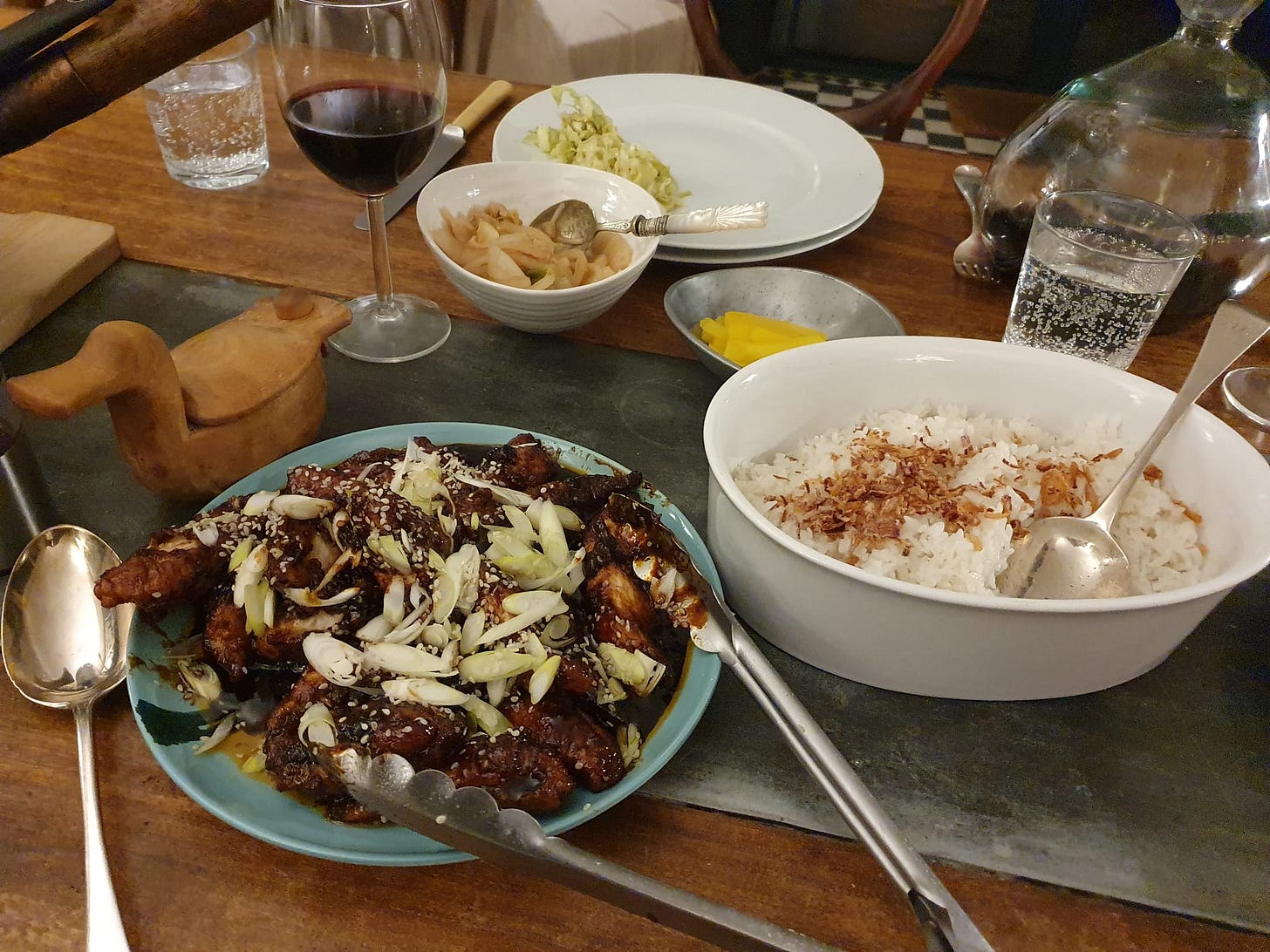The reputation French women have of being abidingly slim was blown some years ago when figures showed that nearly 41 percent of them over 30, and nearly 57 percent of French men, are overweight. One in six of both sexes registers as obese. The French may elect to blame fast food, protesting loudly about the inroads it’s making upon their culinary scene. But the second most profitable market outside the US for McDonald’s is...France.
The French, whose way of life and approach to food is such a magnet to tourists, are emulating the eating habits of the nation they most condemn.
There’s not too much wrong with fast food so long as it’s not a daily solution. It makes a welcome break from cooking, especially after a long day’s work. Besides, at this time of year when endless winter sucks the vitality out of everything, it’s so easy just to heat something up from a foil package.
The media love to chastise us over what and how we eat: it’s a low-budget way to fill a page or time. But when we’re nagged, we’re more likely to console ourselves with forbidden treats.
If you’re going to give in to temptation, relish it. Enjoy every last lick of that Korean fried chicken with coconut sticky rice (I can give you that recipe if you want - this was a delicious feast), or cream-filled meringues (read on),
and don’t feel guilty. Food is not merely fuel. It provides one of life's great, convivial pleasures.
(Speaking of which, that can go for a simple cup of coffee. So if dedicated pleasure is what you’re hoping to draw from one, do you really believe it’s likely to occur to the same degree walking down the street with a paper cup of Java in one hand and your phone in the other? Surely you aren’t so addicted you need to slurp at something you’re only half aware of. Sit down somewhere for ten minutes and relish every expensive sip. Street drinking’s a rare sight in Italy, Greece, or France. They must know something worth copying. But I digress…)
Since the approach to Easter/spring/dressing for the beach can provoke a determination to lose winter cuddles, it’s a good time to consider how to eat. It doesn’t have to be a struggle. Just make a few resolutions, none of which have to do with cutting back.
To enjoy food while staying in good shape and health, cook it yourself as often as possible. You'll eat more thoughtfully, and save money to boot. The price of prepared food from delicatessen counters includes the staff's wages, the rent of the store, utilities, and other hidden charges. Processed food is stuffed with preservatives to keep it safe on supermarket shelves for weeks, and with elevated quantities of sugar and salt to give it a good ‘in-the-mouth’ feel.
Every year, over 1.3 million tons of food is wasted globally, four times the amount needed to feed the 795 million undernourished people around the world. Buy from a local producer where you can. Not only will you be able to establish just what has gone into raising the product or produce, but you will also keep their business going; and if it costs you more initially, you will probably respect your food more and so waste less of it.
Eat in season. What do you believe Peruvian asparagus or strawberries in March can offer you that is better than a local winter cabbage? And besides, what's to look forward to in June if you're eating unseasonal produce all year round?
Watch out for ‘super’ food fads. They’re on the increase and generally promise more than they can deliver. However, there are ingredients in your supermarket that could ease you out of winter into spring in good shape and health.
Sardines: High in omega-3’s, containing virtually no mercury and loaded with calcium. They also contain iron, magnesium, phosphorus, potassium, zinc, copper and manganese, as well as a full complement of B vitamins. Choose sardines packed in olive oil. Eat them smushed with the back of a fork into hot buttered toast and well peppered, mixed into a crisp salad, or mashed with Dijon mustard and minced onion to make a crackers spread.
Swiss chard: Packed with carotenoids that protects the eyes. Sauté in oil with dried chili flakes and garlic.
Pomegranate juice: Loaded with antioxidants, it’s an anti-inflammatory that lowers blood pressure. Just drink it.
Beetroot: A rich source of folate as well as natural red pigments that may be cancer fighters. Grate one raw, well scrubbed, with an equal sized unpeeled apple, adding vinaigrette to make a salad. Cooking decreases its antioxidant power.
Cabbage: Brimful of nutrients like sulforaphane, a chemical said to boost cancer-fighting enzymes. Make coleslaw with julienned fresh ginger and carrots and a sesame oil and Chinese rice vinegar dressing, or stew finely shredded cabbage in butter and a little water until beginning to caramelise.
Cinnamon: It’s thought it may help control blood sugar and cholesterol. Sprinkle powder on your coffee or morning porridge or muesli, or throw a stick into a beef stew.
Prunes: Packed with antioxidants. Eat them raw as a snack, or in your cinnamon beef stew, or wrap each one in prosciutto or bacon and bake until the wrap is beginning to crisp.
Pumpkin seeds: The most nutritious part of the pumpkin, they’re packed with magnesium, high levels of which are associated with lower risk for early death. Sprinkle over a salad or on muesli, or roast as a snack with a little salt.
Pumpkin, fresh or tinned: A low-calorie vegetable high in fibre and immune-stimulating vitamin A, it fills you up on very few calories. Slice into segments, turn in a little vegetable oil, chili flakes and minced garlic and roast, then mix with toasted walnuts and a handful of rocket/arugula. Or steam and toss in a little butter, cinnamon or nutmeg.
Turmeric: Styled “the superstar of spices” and thought to have anti-inflammatory and anti-cancer properties, this latest hipster fad is almost on the wane. Its usefulness is only released once it meets fat and heat, so cook it first in a pan before adding vegetables or pulses to create a curry. Or mix with scrambled eggs.
Blueberries, fresh or frozen. Associated in animal studies with better memory. Even though freezing can degrade some of the nutrients in fruits and vegetables, frozen blueberries are available year-round and don’t spoil. Blend with yogurt and honey into a breakfast smoothie.
Hang in there: It’s only 19 days till spring is officially here and fresh seasonal produce hits the stores.
Meanwhile, don’t deprive yourself entirely. These meringues are not in the least deceptive. They are how exactly as they look, pure - two cooked clouds of sugar and egg whites pressed together with whipped cream. A doddle of a recipe to make.
Serves 4
4 egg whites
a pinch of salt
225g/8oz caster/fine sugar
a smear of soft butter
plain flour
400ml/13fl oz double/whipping cream
2 tablespoons caster/fine sugar
Preheat the oven to 140C/275F.
In a squeaky clean bowl, whip the egg whites with the salt until soft but holding a peak. Beat in half the sugar, one tablespoon at a time, until glossy and stiff. Fold in the remaining sugar using a large metal spoon or spatula. You can be brisk and assertive. The sugar must be well incorporated.
Li8ghtly grease a flat baking sheet with the butter and sift over a spoonful of flour. Shake it around to spread it about then bang off the excess into the sink.
Dollop spoonfuls in an even number onto the tray and bake 1½ hours till the meringues have a latte tinge. Leave to cool before removing them from the sheet.
Whip the cream and sugar together till thick. Plonk a scoop of the mixture onto one meringue and sandwich another one on top.







